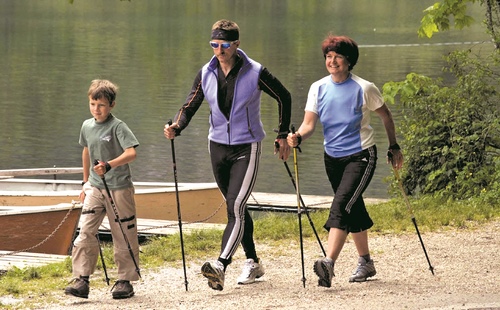Just a few years ago, people would smile to themselves on seeing elderly people walking across Minsk with ski poles. Today, they evoke respect, as Nordic walking (Scandinavian, Finnish or Northern walking) has become recognised not only as a method of raising fitness levels, but is a sport in itself. The founder of the movement in Belarus is an instructor at the Minsk school of Nordic walking, Alexander Mekh.

Nordic walking is now popular
He tells us, “If we count how many people have attended our school, even for one trial lesson, or who have bought equipment, it comes to nearly five thousand. The same number again have bought poles abroad, or have borrowed them from someone else, to give it a try.”
The qualified lawyer is happy to chat about his love for the sport, which he took up not so long ago, having decided that he needed a more sedate form of exercise, having been a surfer, snowboarder, paraglider and cyclist.
“I needed to recover from a spinal injury, sustained while doing extreme sports, and learnt about Nordic walking. At first, I took the usual ski poles, put my child into a knapsack and began walking, to try it out. I found that I very much enjoyed it and was quite carried away! Nobody else in Minsk was regularly walking in this way, so I decided to found a movement. I trained in Russia, receiving certification from the International Federation of Finnish Walking in St. Petersburg.”
It’s hard to say how the sport first began, although it’s thought that skiers are probably behind it. In the 1940s, the Finns began training in this way, to keep in shape, and the practice spread. It’s common now with biathletes, freestylers, and cross-country skiers. The INWA (International Nordic Walking Association) includes more than twenty countries.
Mr. Mekh tells us, “People from the older generation were the first to come to our school. They’d travelled across Europe and had seen their contemporaries engage in this sport. It’s great to see those aged 30-50 joining us. Everyone benefits from Nordic walking, as it relaxes you, strengthens your muscles, keeps you in shape, and can help you lose weight.”
“Lyudmila Kistanova, from Minsk, lost 15kg within two months, and infected neighbours with her enthusiasm. Some families in Stepyanka followed her example. Some who take up Nordic walking have spinal and knee joint injuries. Yelena Shik, who lives near Gorky Park, suffered from arthrosis for a long time but has found relief from taking up the sport. Some walkers need rehabilitation after surgery, such as hip joint replacement, while others are recovering from injury. As for me, after several years of training, my back problems have disappeared, as if by magic. Doctors often now recommend this activity to those rehabilitating,” he continues.
“Variations in technique allow people to tailor their routine to their needs, adding muscle-strengthening exercises, using poles, expanders or TRX loops. Every instructor has their own techniques, which they add from experience, including aspects of yoga, or track and field athletics. All our experts have rich sports experience and can offer valuable advice on how to achieve the best results.”
Mr. Mekh is fond of yoga, and does not eat meat, fish or eggs, although he does consume dairy products. He doesn’t impose his views on anyone though, understanding that each person has their own needs. Equipment for Nordic walking varies too, adjusted to suit the individual.
Patience is importance, and it’s important to follow ‘the rules’ of walking with poles. Mr. Mekh’s Nordic Walking: A Healthy Way of Life book and video (available online) allow anyone to take up the sport, if they have the desire.
By Yelena Davydova











